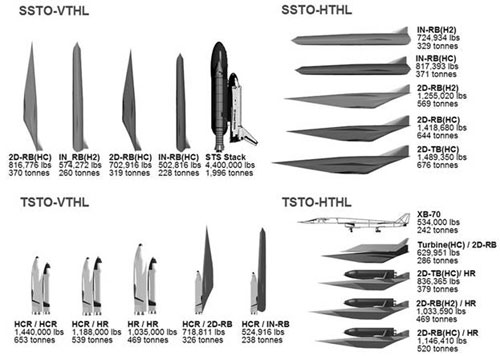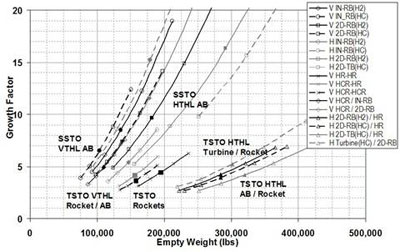
Reassessing scramjets and spaceplanesby Dr. Ajay Kothari
|
 A list of baseline vehicle concepts. |
 The growth factors for various vehicle concepts. |
No, a VTHL would not have turbines with low thrust-to-weight ratio (T/W) of 5–8 (his warning sign at this number is correct, to the point and completely justified!) as described in “Added propulsion subsystem mass”, but instead will have a high T/W rockets in the range of 50–80. This is a rocket-boosted scramjet, an RBCC (Rocket Based Combined Cycle), and not a TBCC (Turbine Based Combined Cycle). Snead did not mention, nor did he have to, having made his point without it, but the wings and the takeoff gear, which would be dependent on the gross takeoff weight, also contribute mightily to making the HTHL SSTO option untenable.
| Half the problem is because of our love affair with the HTHL option, with the other half being with the scramjet itself—which will not go away, but removing one half makes the other half a possibility. |
Snead’s retort at some of the problems of scramjets shows an excellent insight into the overall problem. However, it is not true that the hydrogen tank mass would be larger for scramjets. Two atoms of hydrogen will still combine with one of oxygen whether one scrams or rockets, and the energy released which we use as thrust is still the same. True, there is more of an aero loss (drag) in the scramjet case, but there is less gravitational loss, and smaller oxygen tank—almost an even wash.
He is, on the other hand, quite right in noting an increase in TPS needs, probably even worse than he alludes to, because of the active cooling acreage needed. This may be scramjet’s Achilles’ heel, but we do not know enough at this time. Inward turning helps greatly with this.
Is there an uncertainty in predicting the required propellant fraction? Yes and no. Yes, there is uncertainty, but the amount of impact it will have on the do-ability of a design will be a function of the growth factors. Anything with high GF can quickly spiral out into a nowhere land (like HTHL SSTO). Not so for the VTHL SSTO or even a two-stage HTHL.
On the other hand, his take on the scramjet testing design and verification challenges is quite true, and is debilitating. However, concentrating on the scramjet side, rather than on the TBCC side, will help, perhaps substantially (especially in this era of highly-limited funding!) Additionally, programs such as the Fully-Reusable Access to Space Technologies (FAST) demo can prove to be highly synergistic, as it can be envisioned as the booster for the rocket-boosted scramjet, a precursor to the VTHL SSTO.
While Snead has explained the impact of various aspects on the feasibility of an SSTO design rather beautifully, with uncanny simplicity, actual calculations which take into account all of these aspects (and some more) have been done in a highly integrated fashion, by us and others, some of which have been published in the open literature, in the Journal of Spacecrafts and Rockets for example (see the references below). We had concluded the same for the HTHL SSTO options, but not so for the VTHL SSTO ones. So I beg to differ with him on what scramjets bring to the table.
HTHL SSTO is completely the wrong way to go (for now), but VTHL SSTO is a completely different story: a good, promising story (especially the one with an inward turning design), that we would discard at our peril, at the peril of losing our competitive edge and future competitiveness.
I think VTHL SSTO is possible in 15–20 years (not 30), if we collectively put our minds to it and not get distracted by superfluous things such as turbines/TBCC for HTHL that would be icing on the cake, rather than the cake itself. After all, Apollo was done in less than ten years.
Yes, the rocket technologies are substantially more in hand, but at most it will become a fully reusable yet a TSTO system. One cannot extrapolate it to an SSTO (even a VTHL one). So for that, the scramjet offers the only possibility today.
| I think VTHL SSTO is possible in 15–20 years (not 30), if we collectively put our minds to it and not get distracted by superfluous things. After all, Apollo was done in less than ten years. |
Having said all these in favor of scramjet, the hybrid TSTO rocket solution is highly attractive, yielding about half the direct operation cost (DOC) number of the present-day EELV. So is the fully reusable upper stage, cutting DOC even further, while realizing that it will be at least twice as heavy as its expendable twin, resulting in resizing of the booster.
All three are important solutions. Even more important is that the same reusable rocket first stage can be used as a rocket booster for the VTHL scramjet and it would show us a clear path to an SSTO—a VTHL SSTO.
All in all, to me, the path is clear and simple:
Also, I hope we stop cannibalizing each other, rocket folks versus the scramjetters, as we often tend to. Most of the people involved in this endeavor are brilliant souls and they all bring something to the table. We should all work together.
Dissel, A., Kothari, A. et al, “Investigation of Two-Stage-to-Orbit Air-Breathing Launch Vehicle Configurations”, Journal of Spacecraft and Rockets, AIAA, Vol. 43, No. 3, May-June 2006, pp. 568–574
Dissel, A., Kothari, A. et al., “Comparison of Horizontally and Vertically Launched Air-breathing and Rocket Vehicles”, Journal of Spacecraft and Rockets, AIAA, Vol. 43, No. 1, Jan-Feb 2006, pp. 161–169.